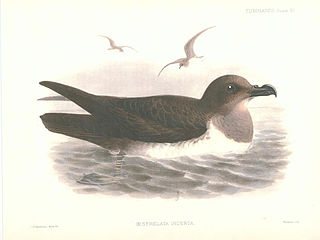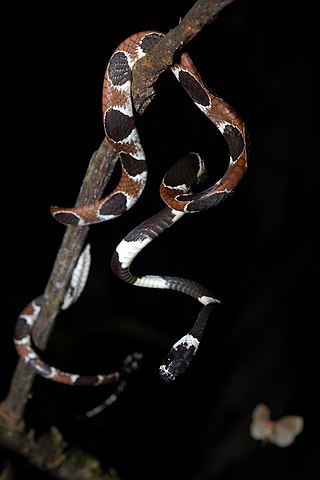
Dipsas variegata, the variegated snail-eater, is a snake found in South America. It is reported to feed almost exclusively on tree snails and slugs.

Dipsas indica, also known as the neotropical snail-eater, is a snake species found in South America. It feeds on slugs and snails, which the snake can extract from their shells using its slender jaw.

The Atlantic petrel is a gadfly petrel endemic to the South Atlantic Ocean. It breeds in enormous colonies on Tristan da Cunha and Gough Island, and ranges at sea from Brazil to Namibia, with most records at sea being to the west of the breeding islands, and along the subtropical convergence. Adults are about 43 cm long, powerful, large, stocky, dark in color with white belly. Their head can appear to be grey in worn plumage. Brown undercoating of wings and tail. These petrels can live on average of 15 years of age.

The lesser ground robin is a species of bird in the family Petroicidae. It is found in New Guinea.

Dipsas is a genus of nonvenomous New World snakes in the subfamily Dipsadinae of the family Colubridae. The genus Sibynomorphus has been moved here. Species of the genus Dipsas are known as snail-eaters.

The graceful snail-eater, is a non-venomous snake found in the northern part of South America . No subspecies are currently recognized.

Catesby's snail-eater, also commonly known as Catesby's snail sucker, is a nocturnal species of nonvenomous snake in the family Colubridae. The species is native to northern South America.
Hyponerita incerta is a moth of the family Erebidae. It was described by William Schaus in 1905. It is found in French Guiana.
Dipsas pakaraima is an arboreal snake of the family Dipsadidae. It has been placed in the Dipsas temporalis group. It is native to medium and higher elevations in west-central Guyana. It has been collected in Kaieteur National Park and Mount Ayanganna. Its food probably consists of snails and slugs.
Dipsas pratti, known commonly as Pratt's snail-eater, is a species of arboreal snake in the subfamily Dipsadinae of the family Colubridae. The species is endemic to northern South America.
There are two species of snake named Jan's snail-eater:

The two-colored snail-eater, is a non-venomous snake found in Honduras, Nicaragua, and Costa Rica.

The snail-eating thirst snake or short-faced snail-eater is a non-venomous snake found in Mexico, Belize and Guatemala. Its length for male is approximately 373 mm and for female 357 mm,. They are oviparous in nature.
Dipsas chaparensis is a non-venomous snake found in Bolivia.
'''Dipsas copei is a non-venomous snake found in Guyana, Suriname, French Guiana, and Venezuela.
Dipsas lavillai is a non-venomous snake found in Argentina, Brazil, Paraguay, and Bolivia.
The Ecuador snail-eater is a non-venomous snake found in Ecuador..

Dipsas pavonina, the northern snail-eater, is a non-venomous snake found in Guyana, Suriname, French Guiana, Venezuela, Brazil, Colombia, Bolivia, Ecuador, and Peru.
Dipsas schunkii, Schunk's snail-eater, is a non-venomous snake found in Peru.









